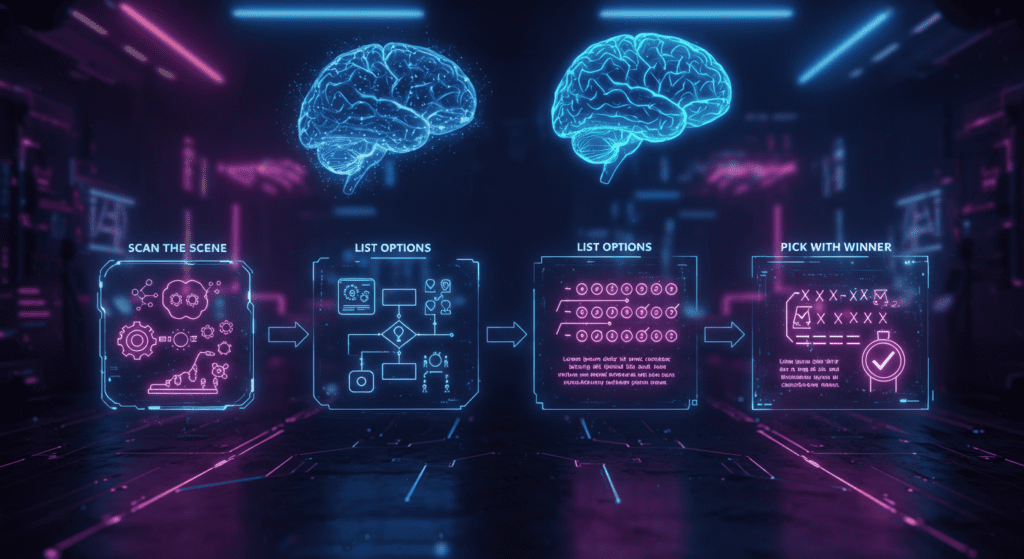Ever wonder how Netflix nails your next binge-watch or how a smart thermostat keeps your house just right? That’s the work of utility-based AI agents, the brainy tech that juggles options to pick the best outcome in a split second. These agents aren’t just chasing one goal—they’re weighing pros and cons like you picking a dinner spot that’s tasty, close, and budget-friendly. So, what are utility-based AI agents?
They’re AI systems built for real-time AI decision-making, using a clever trick called a utility function in AI to maximize results. In this guide, we’ll break down how utility-based AI agents work, dive into examples of utility-based AI agents like recommendation systems, and explore real-time applications of utility-based AI. Let’s get started!
What Are Utility-Based AI Agents, Anyway?
if you’re at a buffet, eyeing pizza, sushi, and cake. You don’t just grab one—you weigh what you’re craving, how hungry you are, and maybe even the calories. That’s how utility-based AI agents roll. These systems, part of intelligent agent design, make choices by assigning scores (or “utility”) to different paths, picking the one with the highest payoff. Unlike goal-based agents that laser-focus on one target, rational agents in artificial intelligence like these balance multiple factors for utility maximization in AI.
In the world of adaptive AI systems, utility-based agents stand out. They’re built on decision theory in AI, which is all about making smart calls under pressure. Think of them as your friend who’s great at picking the perfect movie night plan—except they’re crunching data, not vibes.

How Do These Agents Make Decisions?
Let’s dig into how utility-based AI agents work. At their core is the utility function in AI, a formula that ranks outcomes based on what matters—like speed, cost, or user happiness. Here’s the gist of their process:
- Scan the Scene: They check their surroundings, like sensors spotting traffic or a website tracking your clicks.
- List Options: They map out possible moves—say, suggesting a rom-com or thriller.
- Score with Utility: The utility function gives each option a number based on priorities (e.g., “rom-com = 8/10 for fun, thriller = 6/10”).
- Pick the Winner: They choose the highest-scoring path, tweaking it if new information, such as real-time outcome optimization, pops up.
It’s like choosing a weekend hike—you weigh the distance, views, and how tired you’ll be. Utility-based AI agents do this instantly, making them champs at autonomous decision-making. For instance, a recommendation system might nudge you toward a sci-fi flick because it knows you loved Star Wars.
Why Utility-Based Over Others?
Utility-based AI agents are more flexible than goal-based agents, which stick to one mission (like getting to the airport). They’re like a GPS that finds the fastest route and considers tolls and scenic views. This knack for AI strategy selection makes them perfect for messy, real-world problems where intelligent behavior means balancing trade-offs.
Where Do We See Utility-Based AI Agents?
Real-time applications of utility-based AI are all around us, quietly boosting efficiency and delight. Let’s examine some use cases of utility-based AI in 2025, from streaming to self-driving cars, and show examples of utility-based AI agents.
Recommendation Systems
How does Spotify get you? That’s utility-based AI agents in recommendation systems. Their utility function weighs your listening history, mood, and trends to suggest tracks. The goal isn’t just “play music”—maximizing your enjoyment, maybe nudging you toward a new indie band. By juggling factors like relevance and variety, they nail AI performance optimization, keeping you hooked. These systems thrive on preference modeling, making them a top example of utility-based AI agents.
Autonomous Vehicles
Real-time autonomous agents shine in self-driving cars. imagine a Tesla cruising through rush hour. Its utility-based AI agent doesn’t just aim to reach your office—it balances speed, safety, and fuel. The utility function might score a lane change as “7/10 for time saved, but 4/10 for risk” and decide to stay put. This real-time AI decision-making adapts to traffic jams or sudden braking, showing why adaptive AI systems are key for autonomous decision-making on the road.
Smart Home Devices
Your smart thermostat or Alexa is another star of utility-based AI agents. Let’s say it’s a chilly evening. The thermostat’s utility function weighs energy costs, your comfort, and the weather forecast to tweak the heat. It might decide, “Bump it to 70°F now, but lower it at midnight to save bucks.” This real-time outcome optimization makes intelligent agent design feel like a cozy hug, proving the benefits of utility-based agents in AI for daily life.
Financial Trading
In the fast-paced world of stocks, utility-based AI agents power trading bots. Their utility function juggles profit potential, risk, and market trends to decide when to buy or sell. For example, a bot might skip a volatile stock because its decision theory in AI flags it as too risky, even if the payoff is tempting. This utility maximization in AI thrives in multi-agent systems, where bots compete, showcasing AI strategy selection under pressure.
Gaming AI
Gamers, you’ll love this. In video games, utility-based AI agents make NPCs (non-player characters) feel alive. Take a strategy game like Civilization. The AI opponent weighs military strength, resources, and diplomacy to decide whether to attack or ally. Its utility function ensures intelligent behavior, like holding off an invasion to save gold. These adaptive AI systems create dynamic battles, a stellar use case of utility-based AI in 2025.
Why Are Utility-Based Agents Awesome?
The benefits of utility-based agents in AI are hard to beat:
- Flexibility: They handle shifting priorities, like in real-time applications of utility-based AI.
- Wise Choices: AI decision-making based on utility picks the best path, as in recommendation systems.
- Efficiency: They optimize resources, from energy in smart home devices to cash in trading.
- User Focus: Preference modeling makes experiences personal, like Spotify’s playlists.
These perks make utility-based AI agents a go-to for AI performance optimization, especially in multi-agent systems where decisions ripple.
What’s Tough, and What’s Coming?
Look, utility-based AI agents aren’t flawless. Crafting a utility function in AI that nails every priority is tricky—too much focus on profit might tank user trust. Real-time AI decision-making eats computing power, especially in chaotic settings like stock markets. But in 2025, advances in adaptive AI systems promise sharper rational agents in artificial intelligence. Imagine recommendation systems that predict your mood before you do!

Wrapping It Up
Utility-based AI agents are like your brain’s overachieving cousin, juggling options to nail the best outcome. From examples of utility-based AI agents in recommendation systems to real-time applications of utility-based AI in cars and homes, they’re reshaping how we live and work.
By mastering how utility-based AI agents work and AI decision-making based on utility, we see their power in use cases of utility-based AI in 2025. Want to spot them in action? Check out your next Netflix queue or smart device—it’s probably got a utility-based agent pulling strings. Keep exploring, and you’ll find intelligent behavior everywhere.
FAQs
1. What are utility-based AI agents?
They’re AI systems that pick the best option by scoring outcomes with a utility function in AI, balancing factors like cost or user joy for utility maximization in AI.
2. How do utility-based AI agents work?
They scan data, list choices, score them with a utility function, and pick the top one, adapting fast for real-time AI decision-making, such as in recommendation systems.
3. What are some real-time applications of utility-based AI?
Think recommendation systems, self-driving cars, smart thermostats, trading bots, and game NPCs—all using utility-based AI agents for real-time outcome optimization.
4. What’s a top example of utility-based AI agents?
Recommendation systems like Netflix or Spotify, where utility-based AI agents weigh your tastes to suggest shows, nailing preference modeling.
5. Why care about the benefits of utility-based agents in AI?
They’re flexible, efficient, and user-focused, and by 2025, they will boost AI performance optimization in everything from smart home devices to utility-based AI use cases.

